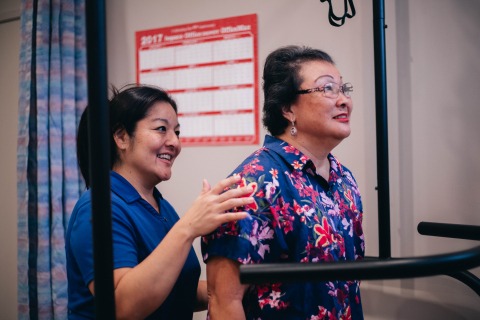
It is known that exercise can improve the quality of life for cancer survivors, but a Hawaii team of researchers sought to discover if exercising with a partner would yield even greater improvements in overall health. A team of women from the University of Hawaiʻi, University of Hawaiʻi Cancer Center, and REHAB Hospital of the Pacific (REHAB), worked together to study the effects of paired versus individual exercise on female cancer patients. Their findings were recently published, in early April, by Supportive Care in Cancer, a peer-reviewed medical journal.
The study was conducted by Dr. Paulette M. Yamada, Faculty of the Department of Kinesiology and Rehabilitation Science at the University of Hawaiʻi at Manoa; Cheri Teranishi-Hashimoto, REHAB’s Therapy Director and Women’s Health & Cancer Rehabilitation Program Director; and Dr. Erin O. Bantum, Associate Professor of the Cancer Prevention in the Pacific Research Division in the Population Sciences of the Pacific Program at University of Hawaiʻi Cancer Center.
Female cancer patients who completed their cancer treatment were placed into either singly trained or paired groups for the study. They participated in three exercise sessions a week for 12 weeks. An exercise specialist knowledgeable in cancer exercise rehabilitation led them through personalized exercise sessions. Interaction between paired patients was supported by asking them to exercise on machines in close proximity to each other, so they would be able to hold conversations or “talk story”. During resistance training, camaraderie was encouraged by using partner exercises and/or by alternating work and rest periods.
The study found that paired participants reported greater benefits in quality of life, emotional well-being, and insomnia and depressive symptoms compared to individual exercisers. Individual and paired participants showed similar improvements in fitness, with the paired patients showing improvements in a few more muscular function tests.
The differences between the groups were explained by the benefit of social connection of the paired group. Exercise is known to alter the level of neurotransmitters. Neurotransmitters alter the perception of stress and outlook (i.e., reduced stress, brighter outlook), and may have mediated paired patients’ perception to exercise. For example, changes in these neurotransmitters may have lowered their perceived exertion during exercise, which actually resulted in paired participants exercising at a higher intensity compared to the singly trained group. Although the authors matched exercise intensity based upon heart rate and relative perceived exertion, having a partner may have reduced the perceived exercise intensity, allowing paired patients to exercise at a higher workload. The authors concluded that the inadvertent higher workloads and the social interaction may have accounted for the psychosocial benefit in the paired group. Thus, exercising with a partner resulted in greater improvements in psychosocial well-being and fitness.
See the study: Paired exercise has superior effects on psychosocial health compared to individual exercise in female cancer patients
REHAB and the University of Hawai‘i Kinesiology and Rehabilitation Science Department also collaborate on iCare, a cancer exercise rehabilitation program. The program offers cancer survivors 12 weeks of personalized training sessions with kinesiology students and measures the benefits of exercise on participants. Learn more about iCare: https://www.youtube.com/watch?v=jwkJJmQ_3Xc.
